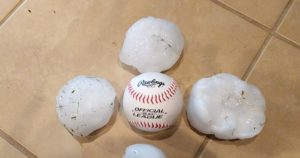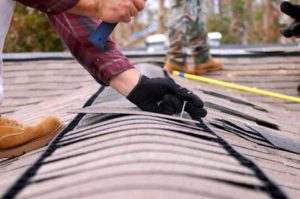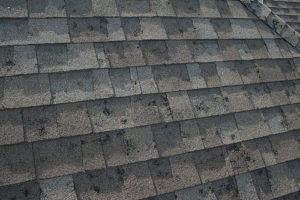Roof Damaged by Hail in San Antonio? Hail stones can damage your home’s roof as well as other personal property you may have. Hail storms can be extremely destructive and the amount of damage caused by hail can vary greatly from one area to the next. For example, homes located side by side can be affected completely differently during the same hail storm. One home’s roof may require a total roof replacement while the home right next to it may only require a few shingles to be replaced. Several factors affect the type of damage and severity of damage caused by a hail storm. First, the changes in wind can affect the severity and the location of hail stone impacts. The shape and size of the actual hail stones is another factor that can affect the degree of hail damage. A pea sized hailstone obviously causes a smaller amount of damage than a hail stone the size of a baseball. Additionally, some hailstones are not smooth but rigid. Rigid misshaped hailstones cause much more damage to roofs and other personal property than smooth and round stones. Another factor that affects the severity of hail stone damage is the type of building materials used on a home’s structure. For example, hail will cause severe dings and dents to aluminum siding and gutters. Additionally, hail stones will ding and dent asphalt shingles but cause cracks to vinyl siding and wood shingles. Golf ball and baseball sized hail stones will actually puncture roofs and siding. Another factor to consider when determining the severity of hail damage is the age of a roof and other building materials on a structure. Typically, older building materials are more vulnerable to hail damage. Barriers around a home also affect the severity of hail storm damage. The position of neighboring structures and natural barriers, like tree coverings, landscaping, fences or adjacent homes can affect the amount of hail stone damage because stones can reflect and bounce off barriers softening the blow to your home.
Shingles can react differently when struck by hail. For example, hail damage to asphalt and composition shingles can look very different than hail damage to wood shingles. Typical hail damage to asphalt and composition shingles is random damage with no discernable pattern. Hail hits on asphalt and composition shingles tend to be black in color, you will see loss of granules on the asphalt shingles, the asphalt shingles will appear shiny, you will see exposed roof felt, and the hail hits may feel soft to the touch like a bruised piece of fruit. Hail hits on wood shingles on the other hand tend to split the shingle with brown or orange discoloration on the wood. The split wood tends to have sharp corners and edges when split by hail. The split wood tends to have very little deterioration at the edges and the splits tend to have marks or dents along the split.

There are other types of damage to shingles that can be mistaken for hail damage. For example, exposure to inclement weather and sunlight makes shingles brittle and gives them an aged appearance. This type of damage is normal wear and tear of shingles, which is sometimes misidentified as hail damage. Other types of normal wear and tear may include blistering, cracking, granule loss, flaking and algae. Manufacturing defects and mechanical imperfections in shingles can also be mistaken for hail damage.
If you believe you have a Roof Damaged by Hail in San Antonio and if your insurance company tries to delay, deny, or underpay your hail claim, contact us today. We have experience dealing with insurance companies, and know the games they play. Many times an insurance company knows that a homeowner may give up and accept a lowball offer. If you don’t want the hassle of dealing with the insurance company yourself, we will be happy to do that work for you.
Feel free to call us at 1-888-724-HAIL.





